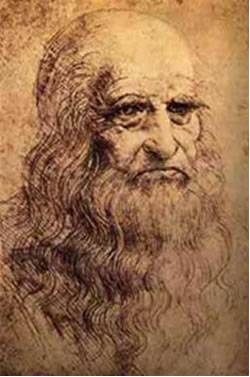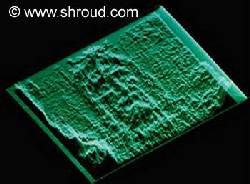The Shroud of Turin proves the Resurrection
Could the Shroud of Turin be the work of Leonardo Da Vinci?

We do not deny that Leonardo da Vinci (1452-1519) was a supremely gifted Renaissance artist, designer, scientist, engineer, and thinker.
Despite his considerable talents, even Leonardo would have faced massive challenges to create the Shroud of Turin,
which we believe would be impossible to create by the cleverest scientists in the world today!
In order to create the Shroud of Turin, Leonardo da Vinci would have to overcome the following seemingly impossible challenges:
- Leonardo would have to create an image of a Crucified Man by scorching the top few fibrils of a large sheet of ancient linen.
- He was not permitted to use any paint, since no paint has ever been found on the Shroud.
- The image had to be scorched both in X-ray radiograph format, and also in photo-negative, a technology not discovered until 1820 approximately, nearly 4 centuries after he lived!
- The scorching had to possess three dimensional properties, so that the VP8 Image Analysing Computer, designed in 1976, could “discover” these properties on the Shroud.
- The VP8 computer was designed 5 centuries after he lived, causing additional problems!
- These three dimensional properties are unique in the World of Art, and no other painting or scorching has ever possessed this property!
Leonardo would therefore have been required make an inspired guess not only about radiography and photography, by also about the VP8 Image Analysing computer technology. None of these were discovered for four to five centuries after he lived!
- The linen of the Shroud itself had to appear authentic, and the fraud clever enough to deceive sophisticated scientist five centuries later!
- The marks of Crucifixion had be clever enough to deceive Dr Robert Bucklin, a 21st century Professor of Pathology, and Forensic Pathologist, (one of the most highly qualified Forensic Pathologists in the world) as well as many other medically qualified authors and investigators.
- Leonardo decided, for an unknown reason, to deviate from the invariable mediaeval practice of illustrating the Crucifixion nail holes in Jesus’ palms, rather than His wrists. This would surely not have been accepted during Leonardo’s lifetime, and his customers would probably have labelled the Leonardo da Vinci fraudulent Shroud as a fraud in Leonardo’s own lifetime!
- Leonardo also apparently knew about the anatomical mechanics of Crucifixion, not well appreciated even today. An example of this is the lengthened arms, and the absent thumbs.
- If Leonardo were able to create the shroud, he evidently illustrated the arms 6 inches too long, and the thumbs of both hands flexed into the palms, both caused by the mechanics of Crucifixion. There are very few individuals alive today who are aware of such gruesome details of Crucifixion.
- The blood on the Shroud had to be painted onto the linen of the Shroud using real human blood, of type AB, the rarest blood group, possessed by only 3% of the population.
- The blood was “painted” on before the Image was created, which is hardly the choice of any artist, even today! Surely every artist we have ever heard of would have “painted” the blood onto the Shroud after the Image had been created first. We use the word “painted” because there is not a single brush stroke on the entire Shroud.
- The completed Shroud contains true human blood, in normal photo-positive, and the Image on the Shroud in X-ray radiograph photo-negative format!
- 16. We cannot think of any reason why Leonardo would ever want to create an Image with such a complicated design which could not be understood during the mediaeval period, due to lack of available technology!
- The blood on the Shroud must contain a high quantity of Bilirubin, a bile pigment completely unknown in Leonardo’s time, and which is present in the blood of victims of severe torture.
- The Bibirubin is bright red, and helped to preserve the bright red colour of the blood, which would otherwise be much darker in colour on the Shroud.
Leonardo evidently was aware of the fact that Bilirubin is present in the blood of tortured victims, even though Bilirubin was unknown at the time!
- There was virtually no understanding about the components of human blood during the mediaeval period.
- For example, doctors routinely bled sick patients to remove this “body humour”, which was considered to be the cause of many illnesses! Doctors probably killed many of their patients, through ignorance about the importance of blood for human life.
- The linen of the Shroud had to clever enough to deceive very high profile 21st century botanists and scientists, including Dr Max Frei (a Swiss Criminologist) Dr. Avinoam Danin (a University Professor) , Dr. Uri Baruch, Oswald Sheuermann, and Dr. Alan Whanger (an Emeritus University Professor) about the pollen on the Shroud. 21st century university botanist all declare that the Shroud originated in the Middle East.
- The dirt on the Shroud (Travertine Aragonite, found only in Jerusalem) had to deceive 21st century sophisticated investigators such as Joseph Kohlbeck, and Richard Levi-Setti.
- The coins over both eyes had to show the images of the A.D. 29 Lepton, minted by Pontius Pilate, and be clever enough deceive Dr Alan Whanger, a 21st century Emeritus University Professor, using highly sophisticated technology, unavailable to Leonardo.
- The above list hardly begins to address the massive problems faced by Leonardo da Vinci, or any other mediaeval forger!
- Virtually all of the above mentioned technology was unavailable during Leonardo’s lifetime, and was not discovered until many centuries later!
- The last major obstacle the Leonardo would have to overcome was to create the Shroud of Turin before he was born!
- Carbon dating is actually very accurate. In 1988 the Carbon dating scientists dated the Shroud from between 1260 A.D. to 1390 A.D.
- Leonardo da Vinci lived A.D. 1452-1519. He would therefore have been required to create the Shroud before his birth!
Our conclusions about a “forged” Shroud of Turin, by Leonardo da Vinci, or any other mediaeval forger:
- So great are the challenges facing a mediaeval forger that the creation of the Shroud of Turin by a forger during this period would be a genuine miracle in its own right!
- It would be similar in difficulty to a 21st century forger today creating an image using a technology that would not be discovered until the 26th century, 500 years from now!
- We believe it would be impossible for anyone alive today to create the Shroud of Turin.
- Carbon dating is actually very accurate. We believe that the Shroud is dated A.D. 33, the date of the Crucifixion. We will explain later why we believe the Shroud is dated by scientists at A.D. 1260 A.D. to 1390 A.D
- Were it not for the Physics of the Resurrection, discussed later, the Shroud would be a fraud, and the correct date really would be 1260 A.D. to 1390 A.D.
- How could Leonardo da Vinci who lived A.D. 1452-1519 possibly have created the Shroud, at least 62 years before he was born?

